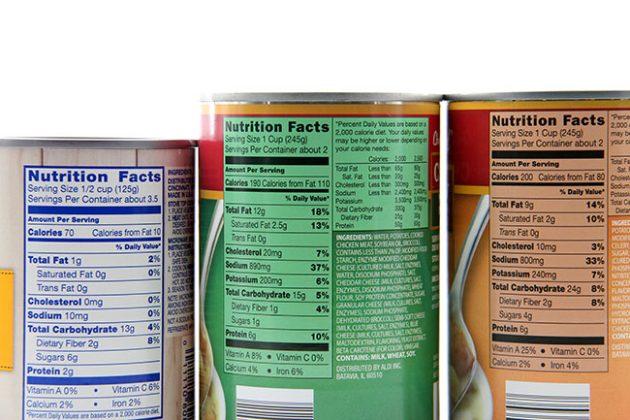
Regulatory Affairs: Nutrition labelling goal posts are on the move
By Gary Gnirss
Regulation Editor pick food labelling Photo © Torian/ Adobe Stock
Photo © Torian/ Adobe Stock Canada’s first mandatory nutrition labelling regulations were registered in 2002. Companies were offered three- and five-year transition periods. The regulations come under federal authority via the Food and Drug Regulations (FDR) and apply to all prepackaged food unless exemptions or alternative methods of providing nutrition information are relevant.
The term, “prepackaged,” includes both consumer and non-consumer packaged food. In 2016, Health Canada finalized amendments to FDR that would modernize nutrition labelling in Canada. A five-year transition period was given, which technically ended on December 14, 2021. The Canadian Food Inspection Agency (CFIA), which governs and enforces food labelling, has extended the transition period until December 14, 2022, for “compliance education and promotion”. CFIA may grant additional time, not exceeding December 14, 2023, for those who plan to bring labelling, including new ingredient labelling rules, into compliance after December 14, 2022. The extension is largely due to the pandemic. During the transition period Canadian consumers will observe labels with the new and former nutrition facts table (NFts).
NFt rules
Despite an NFt being a box of numbers, many rules govern the display of information. It is blueprinted with little room for discretion. This is intended to achieve uniformity among labelled prepackaged foods. It might be surprising to know that the manner in which nutrient values are acquired (i.e. chemical analysis and/or calculated via nutrient data) is not prescribed. Neither is accuracy since FDR does not prescribe tolerances for nutrient values. CFIA has, however, developed a Nutrition Labelling Compliance Test to gauge assurance and compliance. Regardless of how the numbers are acquired, manufacturers will be responsible for demonstrating their accuracy.
Canadian rules on selecting an NFt can be complex. There are 34 NFt categories, and some have subcategories in the Directory of Nutrition Facts Table Formats, which is incorporated by reference (IbR) via FDR.
The former and new rules are both prescriptive in the case of a single-serving prepackaged food. The new rules are a bit more streamlined. Packages less than 200 per cent of the applicable reference amount (RA) are deemed single serving. It is also possible to consider a package with 200 per cent or more of RA as single serving if the content can be reasonably consumed by an individual in one sitting.
Differences
However, the former and new rules differ significantly when it comes to multiple-serving food. The former rules left the decision of what is reasonable to manufacturers. The new rules prescribe how to determine serving size and how to declare that in an NFt. As a result, the new rules bring even more uniformity to nutrition labelling. For example, all multiple-serving soda beverages will have a serving size of “1 1/2 cup (375 ml)”. All slice bread will be two slices, regardless of the weight of a slice. Manufacturers must now find their food listing and reference amounts and how to declare the serving in the Table of Reference Amounts for Food. This is simple if the food is easily found, but sometimes there might be two or more possible categories, or it may not be on the list. Unlike in the US, Canada does not prescribe dual nutrition labelling for amounts 200 per cent and up to 300 per cent of RA.
Once a manufacturer has recruited nutrient data, determined an eligible NFt format and figured out an applicable RA, they can start populating the NFt with accurate numbers. There are some complex and convoluted rounding rules to consider. For example, the amount of trans fat may not be rounded to zero when it is 0.049 g or more when the food based on its serving size and applicable RA is not free of trans fat. This also means the food is low in saturated fat. It’s not always easy rounding to zero in Canada. Certain nutrients like fat, sugars, fibre, sodium, potassium, calcium and iron are required to declare a percent daily value (DV). The new rules have updated these values too. All DVs are now rounded to the nearest one per cent. In the case of vitamins and minerals other than sodium, a manufacturer must first round the quantitative amount before calculating the percent DV. Accuracy also means rounding values as required.
Beyond the current transition period, Health Canada is already consulting on modernizing the Table of Reference Amounts for Food to add food categories that were previously omitted (i.e. edible insects), and to add clarity on different formats of food, (i.e. amounts used to make RA). Heath Canada is also looking at updating DVs for sodium and potassium among different age groups. The proposed DV for potassium for individuals aged four and above is 3,400 mg, which is down from 4,700 mg. The plan is to have this completed and transitioned by December 14, 2023.
Gary Gnirss is a partner and president of Legal Suites Inc., specializing in regulatory software and services. Contact him at president@legalsuites.com.
Print this page